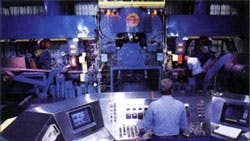Digital drives turn old rolling mill into í90s performer
Worthington Steel’s Columbus facility converts hot rolled sheet steel into cold rolled strip through reduction, annealing, and skinpass operations. Much of this strip goes to automotive, business-machine, and appliance- parts manufacturers.
To increase the capacity of this facility, Worthington, purchased a preowned, 27-in.-wide Watterbury Farrel reversing mill. The newly acquired mill is particularly versatile as it runs 24-in.-wide strip made of low-carbon, highcarbon, high-strength, and exotic grades of steel in thicknesses from 30 to 430 mils. The mill can handle coils weighing 24,000 lb.
To simplify handling the heavy-strip, Worthingon added threading tables, knockdown bars, and holddowns. To improve product quality, the engineers added several instruments, including X-ray gagging equipment.
Six, shunt-wound dc motors power the main sections — a 2,500-hp for the mill stand, two 1,500-hp motors for the right and left reels, and a 200 hp for the payoff reel. These motors were in excellent shape, reported Don Burton, Worthington plant engineer, so they were retained. The rolling components were also quite serviceable.
Control status
Although the basic mechanical equipment and electric motors were in reasonably good shape, the adjustable-speed drive controllers — produced in the 1970s — were analog type and were reported to be troublesome by the previous owner. Mr. Burton commented that from the start of the project, the engineers faced some tough decisions on the drives, especially from reliability and consistency aspects.
Analog devices often change their operating characteristics because of temperature and humidity changes. Also, they drift for no known reason. Moreover, these problems become more acute as components age. Worthington, therefore, investigated the cost of having the old drives completely reconditioned and recommissioned.
Surprisingly, Mr. Burton reported, the prices were nearly half the cost of installing new drives that incorporate the latest digital technology. Such drives are immune to temperature and humidity changes. Plus, there is no drift.
With the increasing emphasis on quality, the stability of digital equipment is paramount. Therefore, Worthington turned to Walco Technologies Group, Providence, R.I., for design and implementation of a retrofit that would include completely new drives and controllers.
Control changes
An experienced system integrator, Walco selected solid-state digital equipment wherever possible. This shift started by replacing logic relays, which handle the interlocking and sequencing functions, with programmable logic controllers.
To control the motors, Walco chose Simoreg packaged units made by Siemens Energy & Automation. These units operate in four-quadrants (capable of motoring and regenerating in both directions, see box). Microprocessor-based, each drive control circuit is programmed by entering operating parameters via a keypad. Such information typically includes acceleration and deceleration profiles with Scurve rounding plus various speed and current limits and instructions for the diagnostic displays.
In operation, the mill speed establishes the speeds of the side and payoff reels. Tension instructions come from one of the new PLCs. By adding an optional controller board, digital speed signals from the mill motor become the master speed reference for the reels so they maintain the proper tension as the reels wind down in speed as they build up with metal strip.
Should it become advisable for the drives to communicate with computers as part of a plant-wide MIS network, additional printed-circuit boards can be added to the drive units.
